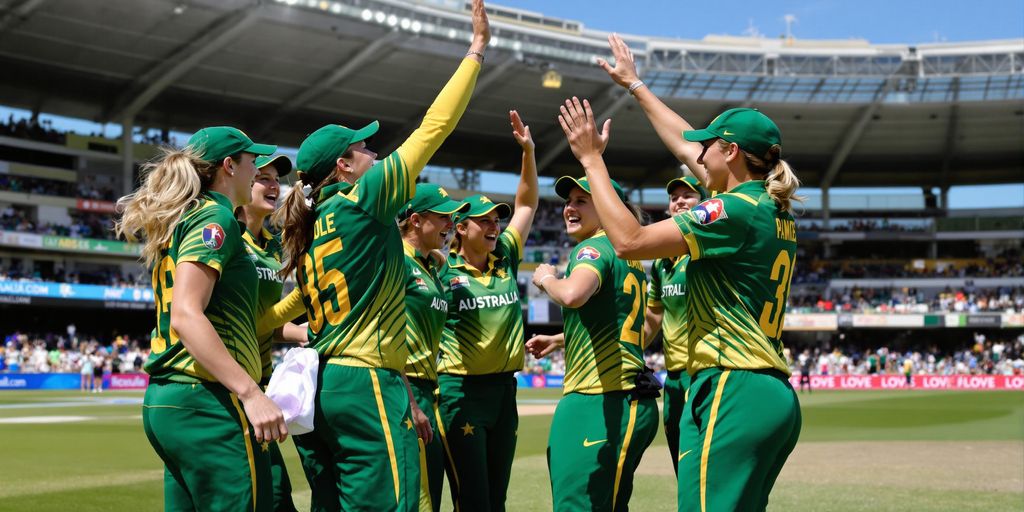The Origins Of The Southern Stars
Early Years Of Women’s Cricket
Okay, so picture this: women’s cricket in Australia, way back when. It wasn’t exactly front-page news, right? More like a quiet thing happening in the background. But that’s where it all started. Early matches were more social than serious, but the passion was there. These women were pioneers, setting the stage for what would become a national obsession. They faced challenges – lack of funding, limited media attention, and sometimes, just plain old disbelief that women could play cricket at all. But they kept at it, building the foundations for the Southern Stars to rise.
The Significance Of The Name
So, why "Southern Stars"? It’s a pretty cool name, isn’t it? It connects the team to Australia’s place in the world, under the Southern Cross constellation. It’s about national pride, about representing the country on the world stage. It gave the team an identity, something to rally around. It wasn’t just a random name; it was a symbol of what they stood for. It also aligned them with other national sporting teams, like the Wallabies and the Socceroos, creating a sense of unity within Australian sport.
Initial Successes Under The Southern Stars
Under the Southern Stars banner, the team started to make waves. It wasn’t an overnight thing, but they were definitely on the up. We’re talking about the late 90s and early 2000s. They started winning more games, competing in major tournaments, and generally showing the world that Australian women’s cricket was a force to be reckoned with. These early wins weren’t just about the scores; they were about building confidence, proving doubters wrong, and inspiring a new generation of female cricketers. It was a time of growth, learning, and laying the groundwork for future dominance.
The Southern Stars name became synonymous with excellence in women’s cricket. It represented not only the team’s skill and determination but also the growing recognition and support for women’s sports in Australia.
Transitioning To A New Era
The Shift In Team Identity
Okay, so things change, right? The Southern Stars had a good run, but eventually, there was a feeling that the team’s identity needed a bit of a refresh. It wasn’t about ditching the past, but more about evolving. This shift aimed to better reflect the current team’s values and aspirations. It’s like when you redecorate your house – you’re not getting rid of all your old stuff, just making it feel a bit more ‘you’ now.
Reasons Behind The Change
Why the change, though? Well, there were a few reasons floating around.
- For starters, there was a push to align the team’s brand with a more modern image.
- Then there was the whole thing about appealing to a broader audience, especially younger fans.
- And let’s not forget the marketing gurus who probably had a say in making the team more marketable.
Basically, it was a mix of wanting to stay relevant, attract new supporters, and, you know, sell more merch. It’s all part of the game, I guess.
Impact On Team Morale
Now, you’d think changing a team’s name wouldn’t be a big deal, but it can actually affect morale. Some players might have felt a bit sentimental about the Southern Stars moniker, especially those who’d been around for ages. But, on the whole, the team seemed to embrace the change. It was seen as a fresh start, a chance to write a new chapter. Plus, new uniforms are always exciting, aren’t they?
The Role Of Media In Name Evolution

Media Coverage Of Women’s Cricket
Media coverage has always played a big part in how the public sees the Aussie women’s cricket team. Back when they were known as the Southern Stars, the media helped build that brand. You’d see the name plastered all over sports reports, and it became synonymous with success. Now, with the change, the media is key in getting everyone on board with the new name. It’s a constant process of building recognition and association.
Public Perception Of The Team
Public perception is everything, right? The media definitely shapes how we all feel about the team. If the media uses the name positively and links it to wins, people are more likely to accept it. If there’s negative press or confusion, it can make the transition harder. It’s a bit of a balancing act, making sure the public feels connected to the team, no matter what they’re called.
Influence Of Social Media
Social media has changed the game completely. It’s not just newspapers and TV anymore; it’s all about what’s trending on Twitter and Instagram. The team’s social media presence, along with fan reactions and hashtags, can really influence how quickly a new name sticks. It’s a direct line to the fans, and it can make or break a rebrand. It’s interesting to see how much power social media has these days.
Social media provides immediate feedback on the name change. The team can monitor sentiment, address concerns, and engage directly with fans to promote acceptance and understanding of the new identity. This level of interaction was not possible in previous eras, making social media a powerful tool in shaping public perception.
Here’s a quick look at how social media engagement might influence the perception:
- Positive hashtags trending
- Increased fan interaction on team posts
- Media outlets picking up social media buzz
Cultural Significance Of The Team Name
Representation Of Australian Identity
Team names, like the Southern Stars, become intertwined with how we see ourselves as a nation. It’s more than just a label; it’s a symbol. The name can evoke feelings of national pride and unity. Think about it – when you hear "Southern Stars", you instantly think of Australia, right? It’s about projecting an image of strength, skill, and Aussie spirit onto the world stage. The latest Matildas jersey embodies this sentiment, connecting fans to a shared identity and passion for the game.
Connection To Indigenous Culture
It’s important for team names to be inclusive and respectful of all cultures within Australia. While the Southern Stars name didn’t have a direct link to Indigenous culture, there’s a growing movement to incorporate Indigenous elements into team branding. This could involve:
- Collaborating with Indigenous artists on jersey designs.
- Including Indigenous language in team communications.
- Partnering with Indigenous communities on outreach programmes.
Acknowledging and celebrating Indigenous culture through the team name and branding can help to create a more inclusive and representative identity for the team and the sport.
Symbolism In Women’s Sports
The name of a women’s sports team carries extra weight. It’s not just about the game; it’s about representation and empowerment. The Southern Stars name, while perhaps a bit generic, did evoke a sense of aspiration and brilliance. The symbolism in women’s sports team names often aims to inspire young girls and challenge traditional gender roles. It’s about showing that women can be strong, successful, and shine on the world stage. It’s interesting to see how Cricket Australia has approached this over the years.
Achievements Under The Southern Stars

Major Tournament Wins
The Southern Stars era was marked by unprecedented success on the global stage. They consistently dominated major tournaments, securing multiple World Cup titles and establishing themselves as the team to beat. It wasn’t just about winning; it was about the manner in which they won, often displaying a level of skill and tactical awareness that set them apart from their rivals. They really set the standard for women’s cricket around the world.
Record-Breaking Performances
Beyond team achievements, individual players consistently broke records under the Southern Stars banner. From scoring the fastest centuries to taking the most wickets in a series, these athletes pushed the boundaries of what was thought possible in women’s cricket. These records weren’t just statistics; they were a testament to the dedication, hard work, and sheer talent within the squad. It was an exciting time to be a cricket fan, watching these players redefine the game.
Legacy Of The Southern Stars
The legacy of the Southern Stars extends far beyond trophies and records. They inspired a generation of young girls to pick up a bat and ball, proving that women’s cricket could be a viable and exciting career path. They changed perceptions, challenged stereotypes, and paved the way for greater recognition and investment in the sport. Their impact on the game is undeniable, and their influence will continue to be felt for years to come.
The Southern Stars era represents a golden age for Australian women’s cricket. Their achievements not only brought pride to the nation but also helped to elevate the profile of women’s sports globally. They showed the world what could be achieved with talent, dedication, and a strong team spirit.
The Current Name And Its Meaning
Introduction Of The New Name
So, the Southern Stars moniker is now a thing of the past. What do we call them now? Well, officially, they’re just the Australian Women’s Cricket Team. Simple, right? No fancy nickname, no catchy slogan. It’s a pretty straightforward approach, and honestly, it’s kind of refreshing. It’s a move away from trying to force a brand and more about just letting the team’s performance speak for itself. It’s a bit like when they renamed the streets in my suburb; all the charm was gone, but at least you knew where you were going.
Fan Reactions And Acceptance
Okay, so how did the fans react? It’s been a mixed bag, to be honest. Some people reckon it’s a bit bland. They miss the Southern Stars and the identity it gave the team. It felt unique, something to rally behind. Others think it’s a good move. They argue that the team’s skill and achievements are what matter, not some marketing gimmick. Plus, it aligns them more closely with the men’s team, creating a unified front for Australian cricket. I think most fans are slowly getting used to it. After all, it’s the cricket that counts, not the name on the jersey.
Alignment With Team Values
Does the new name align with the team’s values? That’s the big question, isn’t it? The idea is that it promotes inclusivity and equality. By not having a separate nickname, it puts the women’s team on the same level as the men’s team. It’s a statement that they’re just as important and just as Australian. It’s about respect and recognition. Whether it truly achieves that is up for debate, but the intention is there. It’s like when you try to be more environmentally friendly by using reusable bags; it’s a small step, but it shows you care.
Ultimately, the name is just a label. What truly matters is the team’s performance, their dedication, and the inspiration they provide to young cricketers across the country. The Australian Women’s Cricket Team will continue to strive for excellence, regardless of what they’re called.
Comparative Analysis With Other Teams
Naming Conventions In Women’s Cricket
When you look around the world of women’s cricket, you see a real mix of naming styles. Some teams stick with a direct link to their men’s counterparts, while others go for something completely different to carve out their own identity. It’s interesting to see how different countries approach this, reflecting their own cultural attitudes towards women’s sport. For example, you might have a national team called the "Lionesses" in England for soccer, showing a clear distinction, whereas in other sports, the women’s team might just be called "The [Country Name] Team".
How Other Teams Have Evolved
It’s not just the Aussie women who’ve gone through a name evolution. Plenty of other national sides have tweaked their branding over the years, often to better reflect their team culture or to appeal to a broader audience. Sometimes it’s a subtle shift, other times a complete overhaul. You see this in other sports too, like how the Australian swimming team went back to using the name ‘Dolphins’ after dropping it for a while. It shows that team names aren’t set in stone and can change with the times. It’s all about finding what resonates with the fans and the players.
Lessons From International Teams
What can we learn from how other teams handle their branding? Well, a few things stand out.
- Firstly, consistency is key. Chopping and changing too often can confuse fans and dilute the brand.
- Secondly, fan engagement is crucial. Get the supporters involved in the naming process, and they’re more likely to embrace the new identity.
- Thirdly, authenticity matters. The name should reflect the team’s values and culture, not just be a marketing gimmick.
Looking at the Indian Women’s cricket team, for example, they haven’t secured a trophy on the global stage yet. The Australian team’s success comes from strong leadership, playing with intent, and not over-relying on individual players. These are lessons that any team can take on board, regardless of their name.
Ultimately, a team’s name is more than just a label; it’s a symbol of their identity and a source of pride for players and fans alike.
The Future Of The Australian Women’s Cricket Team Name
Potential For Further Changes
Okay, so, will the name change again? It’s cricket, anything’s possible! While the current name seems to be sticking, branding is always evolving. Maybe a tweak to better reflect the team’s values or a major sponsor could bring about a change. It’s all about keeping things fresh and relevant, right?
Long-Term Branding Strategies
Thinking long-term, the team’s name is a big part of their brand. It’s not just a label; it’s about what they stand for. A solid branding strategy would involve:
- Consistent use of the name across all platforms.
- Building a strong association with success and sportsmanship.
- Engaging with fans to get their input and build loyalty.
A well-thought-out branding strategy ensures the team’s name remains synonymous with excellence and inspires future generations of cricketers.
Engagement With Future Generations
How do we get the next generation hooked? It’s all about making the team relatable and exciting. Think social media campaigns, player appearances at schools, and maybe even a cartoon series featuring the team! The key is to make cricket cool and accessible to everyone. The Australian cricket team needs to be visible.
Here’s a table showing potential engagement strategies:
| Strategy | Target Audience | Expected Outcome |
|---|---|---|
| Social Media Blitz | Young Adults | Increased awareness and online engagement |
| School Visits | Children | Inspire interest in cricket from a young age |
| Community Events | Families | Strengthen community ties and fan base loyalty |
Influence Of Leadership On Team Identity
Captains Who Shaped The Team
It’s fair dinkum to say that the captains of the Australian Women’s Cricket team have been more than just on-field leaders; they’ve been instrumental in shaping the team’s identity. Think about it – each captain brings their own style, their own values, and their own way of doing things, and that inevitably trickles down to the rest of the team. Some captains might focus on aggressive play, others on building a strong team culture, but each leaves their mark.
Leadership Styles And Their Impact
Leadership styles can really make or break a team. You’ve got your inspirational leaders who motivate through sheer enthusiasm, and then you’ve got your strategic thinkers who are always one step ahead. Meg Lanning, for example, is known for her calm and collected approach, which has helped the team stay focused under pressure. Then you have leaders who really push for innovation and aren’t afraid to try new things. The impact of these different styles is huge – it affects everything from team morale to on-field performance.
Vision For The Future
What’s the big picture? That’s what every good leader needs to have in mind. It’s not just about winning games; it’s about building a legacy, inspiring the next generation, and making a real difference in the sport. A clear vision helps the team stay motivated and united, even when things get tough. The SACA Emerging Leaders Programme is a great example of investing in future leaders, ensuring the team’s values and identity continue to evolve in a positive direction.
Leadership is about more than just tactics and strategies; it’s about creating a culture where everyone feels valued and empowered. It’s about setting a standard of excellence and inspiring others to reach their full potential. It’s about building a team that’s not only successful on the field but also makes a positive impact off it.
Here’s a few things that are important for the future:
- Continuing to develop strong leadership at all levels of the team.
- Fostering a culture of innovation and continuous improvement.
- Ensuring that the team’s values reflect the best of Australian sporting culture.
The Role Of Domestic Competitions
Impact Of The Women’s Big Bash League
The Women’s Big Bash League (WBBL) has been a game-changer for women’s cricket in Australia. It’s not just about the glamour and the increased media attention, although that’s definitely part of it. The WBBL has provided a platform for players to develop their skills in a high-pressure environment, week in, week out. It’s given them more opportunities to play, to learn, and to grow. It’s also made cricket more accessible to fans, with matches broadcast on TV and streamed online, which has helped to build a bigger following for the women’s game.
Nurturing Young Talent
One of the biggest benefits of the WBBL is its role in bringing through the next generation of Aussie cricketers. It gives young players the chance to play alongside and against some of the best in the world, which is invaluable for their development. The exposure to high-quality cricket helps them to improve their skills, their tactical awareness, and their mental toughness.
- More opportunities for young players to gain experience.
- Increased visibility for emerging talent.
- Improved pathways from junior to senior cricket.
Building A Stronger Team Foundation
The WBBL has helped to create a deeper pool of talent for the Australian women’s cricket team. With more players getting regular game time at a high level, the national selectors have more options to choose from. This means that the team is less reliant on a few star players and has a stronger foundation overall. It also means that there’s more competition for places in the national team, which drives everyone to improve.
The WBBL has not only elevated the standard of women’s cricket in Australia but has also fostered a culture of competitiveness and professionalism that benefits the national team immensely. It’s a breeding ground for future stars and a vital component of the Australian cricket landscape.
Fan Engagement And Community Support
Building A Loyal Fanbase
Building a loyal fanbase is super important for any sports team, and the Aussie women’s cricket team is no exception. It’s not just about winning games; it’s about creating a connection with the fans that goes beyond the scoreboard. Think about it – when fans feel like they’re part of something bigger, they’re more likely to stick around through thick and thin. One way to do this is through consistent communication. Keep the fans in the loop with team news, player interviews, and behind-the-scenes content. Social media is your best mate here. Run polls, Q&As, and contests to get fans involved.
Another thing is to make the players accessible. Arrange meet-and-greets, autograph sessions, and community events where fans can interact with their favourite cricketers. This makes the team feel more human and relatable. Plus, it creates lasting memories for the fans, which is always a win.
Community Initiatives And Outreach
Getting involved in the community is a ripper way to build a strong connection with the fans. It shows that the team cares about more than just cricket. Community initiatives can range from visiting local schools to running cricket clinics for kids. Here are a few ideas:
- School visits: Players can visit local schools to talk about the importance of sports and healthy living.
- Cricket clinics: Run free cricket clinics for kids of all ages and skill levels.
- Charity events: Partner with local charities to raise money and awareness for important causes.
These activities not only help the community but also give the team a chance to connect with fans on a personal level. It’s a great way to show that the team is more than just a group of athletes; they’re also role models and community members. Check out the team’s vision and mission for more information.
The Role Of Supporters In Team Identity
The supporters play a massive role in shaping the team’s identity. They’re the ones who cheer the team on, buy the merchandise, and spread the word about women’s cricket. Their passion and enthusiasm can have a huge impact on the team’s morale and performance. It’s like having an extra player on the field. Here’s how supporters contribute to the team’s identity:
- Creating a positive atmosphere: A supportive crowd can lift the team’s spirits and give them the confidence to perform at their best.
- Promoting the team: Fans can help spread the word about the team by sharing news and updates on social media.
- Providing financial support: Buying merchandise and attending games helps to support the team financially, which allows them to invest in better training and resources.
| Supporter Activity | Impact on Team | Example |
|———————-|—————————————————————————————————————————————————————————————————————————————————————————————————————————————————————————————————————————————————————————————————————————————————————————————————————————————————————————————————————————————————————————————————————————————————————————————————————————————————————————————————————————————————————————————————————————————————————————————————————————————————————————————————————————————————————————————————————————————————————————————————————————————————————————————————————————————————————————————————————————————————————————————————————————————————————————————————————————————————————————————————————————————————————————————————————————————————————————————————————————————————————————————————————————————————————————————————————————————————————————————————————————————————————————————————————————————————————————————————————————————————————————————————————————————————————————————————————————————————————————————————————————————————————————————————————————————————————————————————————————————————————————————————————————————————————————————————————————————————————————————————————————————————————————————————————————————————————————————————————————————————————————————————————————————————————————————————————————————————————————————————————————————————————————————————————————————————————————————————————————————————————————————————————————————————————————————————————————————————————————————————————————————————————————————————————————————————————————————————————————————————————————————————————————————————————————————————————————————————————————————————————————————————————————————————————————————————————————————————————————————————————————————————————————————————————————————————————————————————————————————————————————————————————————————————————————————————————————————————————————————————————————————————————————————————————————————————————————————————————————————————————————————————————————————————————————————————————————————————————————————————————————————————————————————————————————————————————————————————————————————————————————————————————————————————————————————————————————————————————————————————————————————————————————————————————————————————————————————————————————————————————————————————————————————————————————————————————————————————————————————————————————————————————————————————————————————————————————————————————————————————————————————————————————————————————————————————————————————————————————————————————————————————————————————————————————————————————————————————————————————————————————————————————————————————————————————————————————————————————————————————————————————————————————————————————————————————————————————————————————————————————————————————————————————————————————————————————————————————————————————————————————————————————————————————————————————————————————————————————————————————————————————————————————————————————————————————————————————————————————————————————————————————————————————————————————————————————————————————————————————————————————————————————————————————————————————————————————————————————————————————————————————————————————————————————————————————————————————————————————————————————————————————————————————————————————————————————————————————————————————————————————————————————————————————————————————————————————————————————————————————————————————————————————————————————————————————————————————————————————————————————————————————————————————————————————————————————————————————————————————————————————————————————————————————————————————————————————————————————————————————————————————————————————————————————————————————————————————————————————————————————————————————————————————————————————————————————————————————————————————————————————————————————————————————————————————————————————————————————————————————————————————————————————————————————————————————————————————————————————————————————————————————————————————————————————————————————————————————————————————————————————————————————————————————————————————————————————————————————————————————————————————————————————————————————————————————————————————————————————————————————————————————————————————————————————————————————————————————————————————————————————————————————————————————————————————————————————————————————————————————————————————————————————————————————————————————————————————————————————————————————————————————————————————————————————————————————————————————————————————————————————————————————————————————————————————————————————————————————————————————————————————————————————————————————————————————————————————————————————————————————————————————————————————————————————————————————————————————————————————————————————————————————————————————————————————————————————————————————————————————————————————————————————————————————————————————————————————————————————————————————————————————————————————————————————————————————————————————————————————————————————————————————————————————————————————————————————————————————————————————————————————————————————————————————————————————————————————————————————————————————————————————————————————————————————————————————————————————————————————————————————————————————————————————————————————————————————————————————————————————————————————————————————————————————————————————————————————————————————————————————————————————————————————————————————————————————————————————————————————————————————————————————————————————————————————————————————————————————————————————————————————————————————————————————————————————————————————————————————————————————————————————————————————————————————————————————————————————————————————————————————————————————————————————————————————————————————————————————————————————————————————————————————————————————————————————————————————————————————————————————————————————————————————————————————————————————————————————————————————————————————————————————————————————————————————————————————————————————————————————————————————————————————————————————————————————————————————————————————————————————————————————————————————————————————————————————————————————————————————————————————————————————————————————————————————————————————————————————————————————————————————————————————————————————————————————————————————————————————————————————————————————————————————————————————————————————————————————————————————————————————————————————————————————————————————————————————————————————————————————————————————————————————————————————————————————————————————————————————————————————————————————————————————————————————————————————————————————————————————————————————————————————————————————————————————————————————————————————————————————————————————————————————————————————————————————————————————————————————————————————————————————————————————————————————————————————————————————————————————————————————————————————————————————————————————————————————————————————————————————————————————————————————————————————————————————————————————————————————————————————————————————————————————————————————————————————————————————————————————————————————————————————————————————————————————————————————————————————————————————————————————————————————————————————————————————————————————————————————————————————————————————————————————————————————————————————————————————————————————————————————————————————————————————————————————————————————————————————————————————————————————————————————————————————————————————————————————————————————————————————————————————————————————————————————————————————————————————————————————————————————————————————————————————————————————————————————————————————————————————————————————————————————————————————————————————————————————————————————————————————————————————————————————————————————————————————————————————————————————————————————————————————————————————————————————————————————————————————————————————————————————————————————————————————————————————————————————————————————————————————————————————————————————————————————————————————————————————————————————————————————————————————————————————————————————————————————————————————————————————————————————————————————————————————————————————————————————————————————————————————————————————————————————————————————————————————————————————————————————————————————————————————————————————————————————————————————————————————————————————————————————————————————————————————————————————————————————————————————————————————————————————————————————————————————————————————————————————————————————————————————————————————————————————————————————————————————————————————————————————————————————————————————————————————————————————————————————————————————————————————————————————————————————————————————————————————————————————————————————————————————————————————————————————————————————————————————————————————————————————————————————————————————————————————————————————————————————————————————————————————————————————————————————————————————————————————————————————————————————————————————————————————————————————————————————————————————————————————————————————————————————————————————————————————————————————————————————————————————————————————————————————————————————————————————————————————————————————————————————————————————————————————————————————————————————————————————————————————————————————————————————————————————————————————————————————————————————————————————————————————————————————————————————————————————————————————————————————————————————————————————————————————————————————————————————————————————————————————————————————————————————————————————————————————————————————————————————————————————————————————————————————————————————————————————————————————————————————————————————————————————————————————————————————————————————————————————————————————————————————————————————————————————————————————————————————————————————————————————————————————————————————————————————————————————————————————————————————————————————————————————————————————————————————————————————————————————————————————————————————————————————————————————————————————————————————————————————————————————————————————————————————————————————————————————————————————————————————————————————————————————————————————————————————————————————————————————————————————————————————————————————————————————————————————————————————————————————————————————————————————————————————————————————————————————————————————————————————————————————————————————————————————————————————————————————————————————————————————————————————————————————————————————————————————————————————————————————————————————————————————————————————————————————————————————————————————————————————————————————————————————————————————————————————————————————————————————————————————————————————————————————————————————————————————————————————————————————————————————————————————————————————————————————————————————————————————————————————————————————————————————————————————————————————————————————————————————————————————————————————————————————————————————————————————————————————————————————————————————————————————————————————————————————————————————————————————————————————————————————————————————————————————————————————————————————————————————————————————————————————————————————————————————————————————————————————————————————————————————————————————————————————————————————————————————————————————————————————————————————————————————————————————————————————————————————————————————————————————————————————————————————————————————————————————————————————————————————————————————————————————————————————————————————————————————————————————————————————————————————————————————————————————————————————————————————————————————————————————————————————————————————————————————————————————————————————————————————————————————————————————————————————————————————————————————————————————————————————————————————————————————————————————————————————————————————————————————————————————————————————————————————————————————————————————————————————————————————————————————————————————————————————————————————————————————————————————————————————————————————————————————————————————————————————————————————————————————————————————————————————————————————————————————————————————————————————————————————————————————————————————————————————————————————————————————————————————————————————————————————————————————————————————————————————————————————————————————————————————————————————————————————————————————————————————————————————————————————————————————————————————————————————————————————————————————————————————————————————————————————————————————————————————————————————————————————————————————————————————————————————————————————————————————————————————————————————————————————————————————————————————————————————————————————————————————————————————————————————————————————————————————————————————————————————————————————————————————————————————————————————————————————————————————————————————————————————————————————————————————————————————————————————————————————————————————————————————————————————————————————————————————————————————————————————————————————————————————————————————————————————————————————————————————————————————————————————————————————————————————————————————————————————————————————————————————————————————————————————————————————————————————————————————————————————————————————————————————————————————————————————————————————————————————————————————————————————————————————————————————————————————————————————————————————————————————————————————————————————————————————————————————————————————————————————————————————————————————————————————————————————————————————————————————————————————————————————————————————————————————————————————————————————————————————————————————————————————————————————————————————————————————————————————————————————————————————————————————————————————————————————————————————————————————————————————————————————————————————————————————————————————————————————————————————————————————————————————————————————————————————————————————————————————————————————————————————————————————————————————————————————————————————————————————————————————————————————————————————————————————————————————————————————————————————————————————————————————————————————————————————————————————————————————————————————————————————————————————————————————————————————————————————————————————————————————————————————————————————————————————————————————————————————————-0000000000000000000000000000000000000000000000000000000000000000000000000000000000000000000000000000000000000000000000000000000000000000000000000000000000000000000000000000000000000000000000000000000000000000000000000000000000000000000000000000000000000000000000000000000000000000000000000000000000000000000000000000000000000000000000000000000000000000000000000000000000000000000000000000000000000000000000000000000000000000000000000000000000000000000000000000000000000000000000000000000000000000000000000000000000000000000000000000000000000000000000000000000000000000000000000000000000000000000000000000000000000000000000000000000000000000000000000000000000000000000000000000000000000000000000000000000000000000000000000000000000000000000000000000000000000000000000000000000000000000000000000000000000000000000000000000000000000000000000000000000000000000000000000000000000000000000000000000000000000000000000000000000000000000000000000000000000000000000000000000000000000000000000000000000000000000000000000000000000000000000000000000000000000000000000000000000000000000000000000000000000000000000000000000000000000000000000000000000000000000000000000000000000000000000000000000000000000000000000000000000000000000000000000000000000000000000000000000000000000000000000000000000000000000000000000000000000000000000000000000000000000000000000000000000000000000000000000000000000000000000000000000000000000000000000000000000000000000000000000000000000000000000000000000000000000000000000000000000000000000000000000000000000000000000000000000000000000000000000000000000000000000000000000000000000000000000000000000000000000000000000000000000000000000000000000000000000000000000000000000000000000000000000000000000000000000000000000000000000000000000000000000000000000000000000000000000000000000000000000000000000000000000000000000000000000000000000000000000000000000000000000000000000000000000000000000000000000000000000000000000000000000000000000000000000000000000000000000000000000000000000000000000000000000000000000000000 cricket clinics. It’s all about showing that the team is there for the fans, both on and off the field.
Wrapping It Up
In summary, the journey of the Australian Women’s Cricket Team from the Southern Stars to their current identity reflects a lot about their growth and success. Their strong domestic leagues have played a big part in shaping talented players who can shine on the world stage. With a mix of solid leadership and a team spirit that’s hard to beat, they’ve shown what it takes to stay at the top. As they keep pushing boundaries, it’s clear they’re not just setting the standard for today but also paving the way for the next generation of female cricketers.




